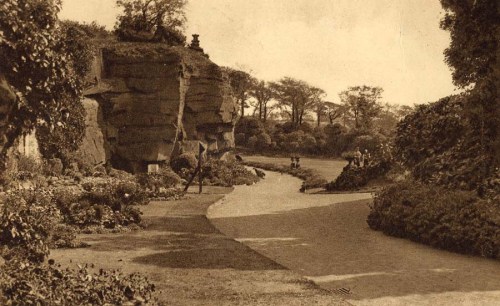I said last time that I would take my Syma X5C-1 2.4G HD Camera RC Quadcopter RTF RC Helicopter with 2.0MP Camera back into history and legend to see if I could find any hints of creatures similar to Bigfoot mentioned over the course of the last 5,000 years or so. I spoke of Enkidu and Moses’ Twelve Spies in the land of Canaan. I also rejected Goliath, an obvious candidate, but not a valid one. Here’s Enkidu’s pal, Gilgamesh again:

In my researches, however, I did find “Beowulf”. This is an Old English epic poem written between 975-1025 AD. It concerns Hrothgar, the king of the Danes, who has grave problems with the fact that his feasting hall is repeatedly being attacked by a monster known as Grendel:
Here’s an old illustration of the creature:

Wikipedia describes events from the point of view of Grendel:
“Grendel is “harrowed” by the sounds of singing that come every night from the hall. He is unable to bear it anymore, and attacks. Grendel continues to attack the Hall every night for twelve years, killing its inhabitants and making this magnificent hall unusable. Beowulf arrives to destroy Grendel. He is welcomed with a banquet. Beowulf and his warriors bed down in the hall to await the creature. Grendel stalks outside the building for a time, spying the warriors inside. He makes a sudden attack, bursting the door with his fists and continuing through the entry. The first warrior Grendel finds is asleep, so he seizes the man and devours him.”
There are so many similarities here with the behaviour of Bigfoot. Active at night, attracted by noise, stalking round the building, looking at the people inside, smashing in through the door, and, certainly according to some of the tales of the Native Americans, eating one of the humans.
Grendel’s exact appearance is never directly described by the original Beowulf poet, except that he is “man-like”. He is referred to as a “sceadugenga”, which means “a shadow walker, a night goer”. This latter phrase, “night goer”, is a good fit for Bigfoot.
I’ve already shown you an older illustration of the monster. More modern sources such as films seem to just do what they feel like on the day:

Mind you, Grendel is big. So big, in fact, that when his head is finally cut off, it takes four men to move it. This is Goliath’s head, but I’m sure you’ll get the idea and that you’ll forgive me, especially when you notice the stone shaped hole in the Big Man’s forehead :

Back to the story. Having seen what he was dealing with, Beowulf decides to fight Grendel without using any weapons because he thinks he can match him. As Grendel comes into the hall, Beowulf leaps up and grabs his hand. Beowulf’s retainers come to help but their swords are unable to pierce Grendel’s skin. Beowulf then rips off Grendel’s arm and Grendel flees to the marsh where he lives and, indeed, dies.
Some excellent similarities there. Grendel’s size, his home in a watery place such as a marsh and his impenetrable skin.
A translation of the poem by Seamus Heaney in 1999 describes Grendel’s arm which gets ripped off in the struggle:
“Every nail, claw-scale and spur, every spike
and welt on the hand of that heathen brute
was like barbed steel. Everybody said
there was no honed iron hard enough
to pierce him through, no time proofed blade
that could cut his brutal, blood-caked claw.”
The Iroquois, a Native American tribe of the eastern Great Lakes area, described a whole race of giants twice as big as men, with bodies covered in rock-hard scales that repelled all of their weapons. Here we are:
Modern man has also repeatedly been baffled by the apparent ability of Bigfoot to escape both rifle and shotgun fire.
I’ll finish with three quick references to literature and legend of roughly the same period. Firstly the “kelpie” of Celtic folklore which is often seen as a water horse, but which could change shape and become a “rough, shaggy man who leaps behind a solitary rider, gripping and crushing him… tearing apart and devouring humans”.
Secondly a tale comes from Norway (not that far from Beowulf territory) called “Konungs skuggsjá” or Speculum Regale or “the King’s Mirror”. It was written around 1250 and describes a “wild man”
“It once happened in that country (and this seems indeed strange) that a living creature was caught in the forest as to which no one could say definitely whether it was a man or some other animal; for no one could get a word from it or be sure that it understood human speech. It had the human shape, however, in every detail, both as to hands and face and feet; but the entire body was covered with hair as the beasts are, and down the back it had a long coarse mane like that of a horse, which fell to both sides and trailed along the ground when the creature stooped in walking.”
The mane on this unknown, hairy creature…is that the origin of the confusion about the shape-shifting Kelpie which was both a “rough, shaggy man” and a water horse?
Perhaps it looked a little bit like the fake documentary made recently:

The third detail involves the Long Man of Wilmington who adorns a hillside in East Sussex. He is 235 feet tall and he is cunningly designed to look perfectly in proportion when viewed from below. He dates from, apparently, the 1600s and he carries two large sticks, and, even allowing for the effects of perspective, he does have enormously long arms, just like Bigfoot:

And next time, “ce sera une visite en France”.

































